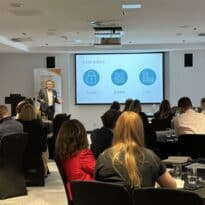Matt Cioppa, Portfolio Manager, Franklin Technology Fund, looks at the development of AI technologies in the context of previous technology disruptors and why it means for investment opportunities.
2025 has brought significant volatility to equity markets, and the technology sector has been no exception. AI debates and tariff uncertainty prompted a 26% decline in the MSCI World Information Technology Index from late February to early April, only for it to completely reverse course and return to all-time highs as of the last week of June. Where to from here? In the very near term, visibility is low given the geopolitical backdrop, but for investors with duration, there’s plenty of reason for optimism.
The technology sector is having a relatively rare moment. About once every decade or so, a new foundational computing technology emerges that sets off a firestorm of innovation, disruption, and the formation of large new markets. The prior three decades brought us the internet, mobile, and cloud computing. In this decade, it’s generative AI. These foundational technologies – and the markets they have created (e.g. ecommerce, social media, ridesharing, and software as a service, to name a few) – have driven dramatically faster earnings growth for the sector relative to the broader market. This has translated to significant sector outperformance, particularly if you look back over the last ten years as all of these technologies converged and digital transformation accelerated.
Critically, we’re still early in the AI wave, akin to mobile circa 2009-2010. By then, we had two years to get comfortable with the iPhone and other smart devices, but we hadn’t yet experienced the explosion of mobile applications – or the network performance upgrades (e.g. 4G and 5G wireless) – that combined drove rapid adoption and eventual ubiquity. AI adoption is moving faster. It’s widely reported that OpenAI, a leading AI model and applications company, has well over 500 million users active on its ChatGPT platform every week, a staggering figure considering the age of the company. However, we are still in the “discovery” phase across many parts of the economy. Large businesses are working hard to find AI talent, integrate AI with disparate and proprietary data sets, and ensure AI can execute on tasks both consistently and securely. It won’t happen overnight, but there is signal in how early adopters are already benefitting from AI in areas like software development and customer support.
The market has mixed feelings about the sheer level of investment that AI has garnered to date. Indeed, the world’s largest technology companies, including many of the so called Magnificent Seven, are spending hundreds of billions of dollars in aggregate to build and equip the data centers needed to support AI demand. On top of this, there are massive sovereign AI initiatives planned, such as those recently announced by the UK, UAE and Saudi Arabia. Within historical context, this level of investment for a new technology is unprecedented, surpassing the likes of the Manhattan Project in the 1940s and the Space Race in the 1960s.
On the one hand, this magnitude speaks to AI’s transformative potential. On the other hand, it sets a high bar for return on investment. The good news is that AI is becoming both more capable, and cheaper to consume, at a pace that far exceeds Moore’s Law. Within the last six months, we have been introduced to models that can reason through complex problems, surf the web and transact on our behalf, generate studio quality video, and perform complex software development work. Our work suggests these advancements are driving an inflection in demand in recent months. Ultimately, the potential prize is higher productivity and economic growth. Labor accounts for roughly $60 trillion of global GDP. A 5-10% productivity boost amounts to $3-6 trillion dollars, and it’s quite possible that over the long run, this understates AI’s potential. Consider that we are also on the cusp of “physical AI” transformation, with large new markets like autonomous driving and intelligent robots just getting started. In this context, the current pace of investment appears rational.
We continue to see opportunities for investors in both AI “infrastructure” and “applications.” We have conviction that the chip companies that serve the data center market will see robust growth for years to come on the AI theme, and that the market will be shared by more players than just Nvidia. We also believe the adoption of AI “agents” in the enterprise will bring opportunities for software companies that help businesses combine the power of AI with their unique data and workflows. Thus, our major focus today remains on these two critical industries, semiconductors and software. Geographically, while we see and invest in opportunities across the globe, we remain concentrated in the United States. Despite a rapidly evolving geopolitical climate, the innovation ecosystem is alive and well, creating fertile ground for quality technology businesses both up and down the market cap spectrum.
Main image: martin-martz-wWW9acEqiw0-unsplash-






























